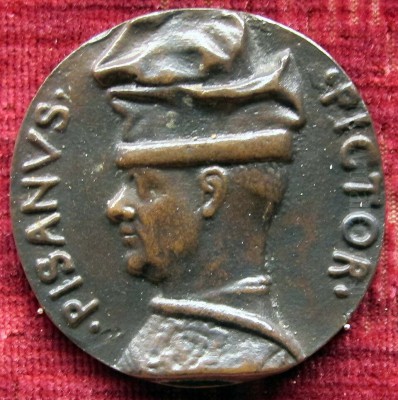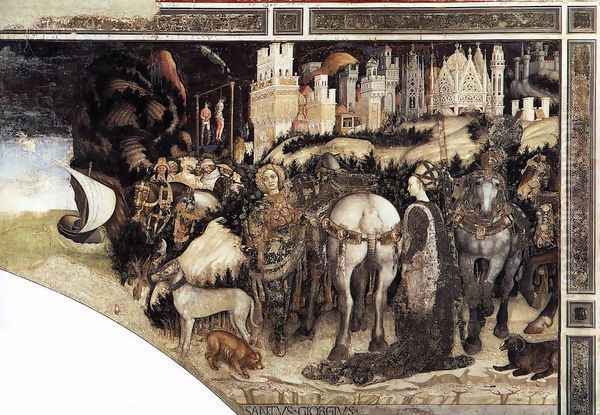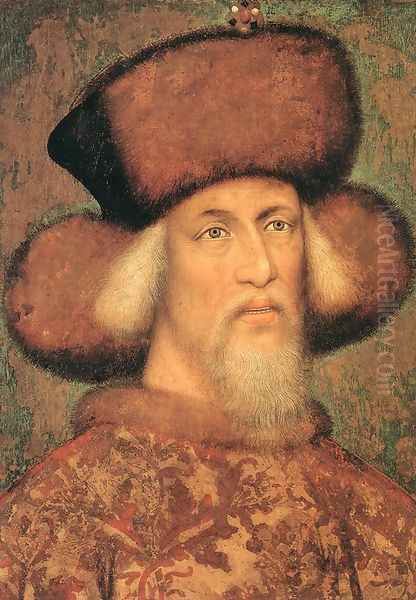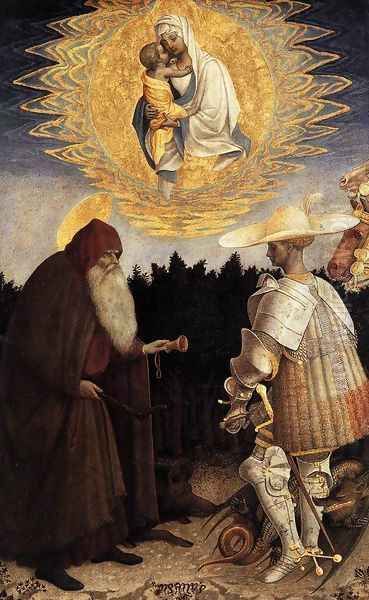
Antonio di Puccio Pisano, more famously known as Pisanello (c. 1395 – c. 1455), stands as one of the most enchanting and significant artists of the late Gothic period in Italy, a master whose work also heralded the burgeoning spirit of the Renaissance. Renowned as a painter of exquisite frescoes and elegant panel portraits, a brilliant draughtsman, and arguably the most important medallist of his era, Pisanello's art captures a world of courtly elegance, chivalric romance, and a burgeoning scientific interest in the natural world. His career spanned several influential Italian courts, leaving an indelible mark on the artistic landscape of the Quattrocento.
Origins and Early Life: The Verona-Pisa Connection
The precise birthdate and birthplace of Antonio Pisanello remain subjects of scholarly discussion, a common ambiguity for artists of his time. While the name "Pisanello" ("the little Pisan") strongly suggests an origin in Pisa, and indeed his father, Puccio di Giovanni de Cereto, was a Pisan cloth merchant, compelling evidence also points to Verona as his formative environment, if not his actual birthplace. Most art historians now concur on a birth year around 1395. His mother, Isabetta, was Veronese, and it is documented that Pisanello spent his youth in Verona following his father's early death.
This Veronese upbringing was crucial. Verona, at the turn of the 15th century, was a vibrant artistic center, still deeply imbued with the International Gothic style, a sophisticated and courtly manner characterized by elegant lines, rich colors, and decorative patterns. Artists like Stefano da Verona were prominent figures there, and their influence, with its emphasis on graceful figuration and detailed rendering of textiles and nature, would have been absorbed by the young Pisanello.
Apprenticeship and the Influence of Gentile da Fabriano

The most significant formative influence on Pisanello was undoubtedly Gentile da Fabriano (c. 1370 – 1427), a leading exponent of the International Gothic style in Italy. While direct documentary proof of a formal apprenticeship is scarce, the stylistic affinities are undeniable, and it is widely accepted that Pisanello was Gentile's pupil and collaborator. Gentile's work, such as his celebrated Adoration of the Magi (1423, Uffizi, Florence), is famed for its opulent detail, delicate modeling, and lyrical observation of nature, qualities that Pisanello would master and make his own.
Pisanello likely worked with Gentile in Venice on frescoes in the Doge's Palace around 1415-1420. These works, tragically lost to fire in 1577, depicted scenes from the life of Frederick Barbarossa. This collaboration would have exposed Pisanello to the highest levels of patronage and the grand scale of monumental fresco painting. After Gentile's departure for Florence and then Rome, Pisanello continued to develop his own distinct voice, though the refinement and meticulousness of his master remained a constant.
A Peripatetic Career: Courts and Commissions
Pisanello's career was characterized by his movement between various powerful courts in Northern and Central Italy, a testament to his widespread fame and the demand for his skills. He served the Gonzaga family in Mantua, the Este in Ferrara, Filippo Maria Visconti in Milan, Alfonso V of Aragon in Naples, and also worked in Pavia, Rome, and Florence. This itinerant lifestyle was common for court artists, who provided not only paintings and frescoes but also designs for tapestries, festivities, and, in Pisanello's case, portrait medals.
In Mantua, under Ludovico Gonzaga, Pisanello executed significant fresco cycles. Around 1424-1426, he worked in the Castello di San Giorgio. Later, in the 1440s, he painted a cycle of chivalric scenes, likely depicting the Tournament of Louvezerp from the Arthurian legends, in the Ducal Palace. Fragments of these, rediscovered in the 1960s in what is now called the Sala del Pisanello, reveal his mastery of dynamic composition, his keen observation of horses and armor, and his ability to evoke the pageantry of courtly life. These frescoes, though damaged, showcase his mature style, blending Gothic narrative charm with an increasing naturalism.
His work in Rome included frescoes in the Basilica of St. John Lateran, undertaken after Gentile da Fabriano's death in 1427 to complete a cycle Gentile had begun. These too are now lost, but contemporary accounts praised their beauty. Pisanello's presence in Rome would have exposed him to the classical antiquities that were beginning to inspire Renaissance artists, an influence particularly evident in his later medal designs.
Master of the Fresco: Surviving Masterpieces

While many of Pisanello's large-scale fresco projects have been lost or survive only in fragments, some notable examples endure, offering a glimpse into his monumental vision. One of his most celebrated surviving frescoes is St. George and the Princess of Trebizond, located on the arch of the Pellegrini Chapel in the Church of Sant'Anastasia, Verona. Painted around 1433-1438, this work is a quintessential example of late Gothic narrative art. The scene is crowded with figures, horses, and architectural elements, rendered with Pisanello's characteristic attention to detail. St. George, the epitome of chivalric virtue, prepares to slay the dragon, while the elegantly attired princess looks on. The background features a fantastical cityscape and a dramatic sky. The depiction of the horses is particularly noteworthy, showcasing Pisanello's profound understanding of animal anatomy, a skill honed through countless drawings.
Another significant, though debated, fresco is the Annunciation in the Church of San Fermo Maggiore, Verona, located above the Brenzoni monument. While the monument's sculpture is by the Florentine Nanni di Bartolo, the fresco surrounding it, dating to around 1426, is attributed to Pisanello. It displays a delicate lyricism and a rich palette, with the figures of Gabriel and Mary rendered with an ethereal grace typical of the International Gothic. The intricate architectural setting and the inclusion of finely observed birds further point to Pisanello's hand.
Elegance in Panel Painting: Portraits and Devotional Works
Pisanello was also a highly accomplished painter of panel portraits, a genre that was gaining prominence in the 15th century. His portraits are characterized by their strict profile view, a convention derived from classical coins and medals, and by their exquisite rendering of costume, jewelry, and individual features. These works are not just likenesses but also celebrations of status and refinement.
Perhaps his most famous panel portrait is the Portrait of a Princess (Ginevra d'Este?), now in the Louvre Museum, Paris. Dated to around 1435-1440, it depicts a young woman in profile against a background of columbines and butterflies, symbols of fertility and perhaps marriage. Her elaborate hairstyle, the richness of her brocaded sleeve, and the delicate rendering of her features are all hallmarks of Pisanello's meticulous style. The identity of the sitter is debated, with Ginevra d'Este, who married Sigismondo Pandolfo Malatesta, being a strong candidate.
Another notable portrait is that of Lionello d'Este (c. 1441, Accademia Carrara, Bergamo), the Marquis of Ferrara, who was one of Pisanello's most important patrons. This profile portrait, like his medals of Lionello, emphasizes the ruler's noble bearing and intellectual refinement. Pisanello's ability to capture not just the physical likeness but also the sitter's character, within the formal constraints of the profile portrait, was exceptional.

Beyond portraits, Pisanello also created devotional panel paintings. The Vision of Saint Eustace (c. 1438-1442, National Gallery, London) is a remarkable example. It depicts the Roman general Placidus (later St. Eustace) encountering a stag with a crucifix between its antlers during a hunt. The painting is a tour-de-force of naturalistic detail: the forest is teeming with meticulously rendered animals – stags, hounds, bears, birds – all observed with an almost scientific precision. This fascination with the animal kingdom is a recurring theme in Pisanello's work, evident in his numerous drawings. The painting combines a courtly hunting scene with a profound spiritual moment, all set within a landscape that, while idealized, is filled with acutely observed natural elements. This work shows Pisanello moving beyond the purely decorative aspects of the Gothic towards a deeper engagement with the natural world, a key characteristic of the emerging Renaissance.
The Unrivaled Medallist: A Renaissance Innovation
Pisanello's most unique and perhaps most enduring contribution to art history was his role as the effective inventor and supreme master of the Renaissance portrait medal. Drawing inspiration from ancient Roman coins, which he studied avidly, Pisanello transformed the medal into a portable, durable, and highly personal form of commemoration and propaganda. These cast bronze medals, typically featuring a profile portrait of the sitter on the obverse and an allegorical or symbolic scene on the reverse, were commissioned by rulers, nobles, and humanists to celebrate their achievements, virtues, and lineage.
His first documented medal, and one of his most famous, was created in 1438 for the Byzantine Emperor John VIII Palaiologos, who was in Ferrara for the Council of Florence. The obverse shows a striking profile portrait of the bearded emperor in his distinctive pointed hat. The reverse depicts the emperor on horseback before a wayside cross, a scene possibly alluding to his journey or his piety. The clarity of the portrait, the skillful modeling in low relief, and the elegant Latin inscriptions set a new standard for medallic art.
Pisanello went on to create medals for many of the most prominent figures of his time, including Filippo Maria Visconti of Milan, Sigismondo Pandolfo Malatesta of Rimini, Francesco Sforza of Milan, and numerous members of the Este and Gonzaga families. For Lionello d'Este alone, he produced at least five different medals, each with a unique reverse design, often alluding to themes like marriage, learning, or princely virtue. For example, one medal of Lionello shows him on the obverse and on the reverse a lion being taught to sing by a cupid, a charming allegory of love taming strength or perhaps an allusion to Lionello's patronage of the arts.
His medals for Alfonso V of Aragon, King of Naples, are particularly impressive. One, dated 1449, shows the king enthroned on the obverse, and on the reverse, an eagle perched atop a dead fawn, surrounded by other birds of prey, symbolizing Alfonso's power and magnanimity ("Liberalitas Augusta"). The technical skill required to cast these intricate designs in bronze was considerable, and Pisanello's medals were prized as much for their artistry as for their commemorative function. They were exchanged as gifts, collected by humanists, and served to disseminate the image and ideals of their sitters far and wide. Artists like Matteo de' Pasti, Sperandio of Mantua, and Giovanni Boldù were directly influenced by Pisanello's medallic work, carrying the tradition forward.
The Master Draughtsman: Studies from Life and the Vallardi Codex
Central to Pisanello's artistic practice was his prodigious activity as a draughtsman. A vast collection of his drawings, known as the Vallardi Codex, is preserved in the Louvre Museum. These several hundred sheets are filled with studies of animals, birds, human figures, costumes, and compositional sketches. They reveal an artist of insatiable curiosity and extraordinary powers of observation.
His animal studies are particularly renowned. He drew horses in every conceivable pose, capturing their anatomy, movement, and spirit with astonishing accuracy. Dogs, deer, monkeys, leopards, and a vast array of birds, both common and exotic, fill the pages of his sketchbooks. These were not merely idle doodles but careful studies from life, often annotated, which served as a repository of motifs for his paintings and medals. This intense study of nature aligns Pisanello with the empirical spirit of the early Renaissance, even as his overall style retained Gothic elegance. Artists like Paolo Uccello, a Florentine contemporary, also showed a keen interest in animal studies and perspective, though their stylistic approaches differed.
The drawings also include sensitive portraits, studies of classical sculpture, and elaborate costume designs, reflecting the multifaceted demands placed upon a court artist. The delicacy of his silverpoint drawings, the fluidity of his pen-and-ink sketches, and his occasional use of watercolor demonstrate his versatility as a graphic artist. These drawings are invaluable not only for understanding Pisanello's working methods but also as artworks of great beauty in their own right. They provide a more intimate glimpse into his artistic mind than his more formal public commissions.
Artistic Style: A Bridge Between Gothic and Renaissance
Pisanello's style is often described as the culmination of the International Gothic, yet it also contains elements that anticipate the Renaissance. His art is characterized by:
Elegance and Refinement: A lyrical line, graceful figures, and a love of decorative patterns are hallmarks of his Gothic heritage.
Meticulous Detail: He rendered textures – fabrics, fur, feathers, armor – with painstaking care.
Observation of Nature: His acute studies of animals and plants brought a new level of naturalism to his work, moving beyond Gothic conventionalization.
Courtly Subject Matter: Scenes of chivalry, hunting, and aristocratic life dominate his oeuvre, reflecting his patrons' tastes.
Classical Influence: Particularly in his medals, the profile format, Latin inscriptions, and allegorical reverses show a clear engagement with classical antiquity, a cornerstone of Renaissance humanism.
While Pisanello did not fully embrace the revolutionary developments in perspective and human anatomy pioneered by Florentine artists like Masaccio, Filippo Brunelleschi, and Donatello, his work represents a distinct and equally valid artistic path. His focus remained on the beauty of the surface, the richness of detail, and the evocative power of narrative and symbolism. He shared with contemporaries like Fra Angelico a love for luminous color and delicate execution, though Fra Angelico's art was more purely devotional and rooted in the Florentine tradition.
The Enigma of Pisanello: Name, Dates, and Legacy
Despite his fame, aspects of Pisanello's life remain obscure. His exact death date is uncertain, though it is generally placed around 1455, possibly in Rome or Naples. For centuries, there was confusion over his name, largely due to the 16th-century art historian Giorgio Vasari, who in his Lives of the Most Excellent Painters, Sculptors, and Architects, mistakenly referred to him as "Vittore Pisano," conflating him with other Veronese artists. This error persisted for a long time, obscuring Pisanello's true identity and achievements. It was only through later archival research that his correct name, Antonio di Puccio Pisano, and a clearer picture of his career emerged.
Pisanello's influence was significant, particularly in Northern Italy and in the field of medallic art. His pupils and followers continued his tradition of detailed naturalism and courtly elegance. While the mainstream of Italian Renaissance art, particularly in Florence and Rome, moved in a different direction, emphasizing monumental form, classical proportion, and dramatic humanism (as seen in the work of artists like Andrea Mantegna, who also worked for the Gonzaga but developed a much more classically austere style, or Piero della Francesca with his geometric clarity), Pisanello's art represents a brilliant flowering of a different sensibility.
His works are now treasured in major museums worldwide, including the National Gallery in London, the Louvre in Paris, the Accademia Carrara in Bergamo, and various collections in Verona and Mantua. His medals are particularly prized by numismatists and art historians alike.
Unresolved Questions and Enduring Fascination
Several mysteries and points of debate continue to surround Pisanello. The precise attribution of certain works, the exact chronology of his travels, and the full extent of his lost frescoes remain subjects for scholarly investigation. The rediscovery of the Mantuan frescoes in the Sala del Pisanello in 1969 was a major event, adding significantly to our understanding of his work, but also highlighting how much may still be unknown or lost.
The very nature of his art, poised between two great epochs, makes him a figure of enduring fascination. He was an artist who looked back to the chivalric ideals and decorative splendor of the Gothic world, yet also forward to the Renaissance's renewed interest in classical antiquity and the empirical study of nature. His unique synthesis of these elements resulted in an art of extraordinary beauty, technical brilliance, and captivating charm.
Conclusion: A Singular Vision in a Time of Transition
Antonio Pisanello was more than just the last great Gothic painter in Italy; he was an innovator who imbued the courtly traditions of his time with a fresh, observant eye and pioneered an entirely new art form in the portrait medal. His meticulous craftsmanship, his profound love for the natural world, and his ability to capture the refined atmosphere of the Italian courts secured him a unique and esteemed place in the history of art. While his contemporaries in Florence were forging a new artistic language based on perspective and classical humanism, Pisanello offered a different, but no less compelling, vision – one of exquisite detail, lyrical beauty, and enduring elegance. His legacy, preserved in his surviving frescoes, luminous panel paintings, unparalleled drawings, and groundbreaking medals, continues to enchant and inspire. He remains a testament to the rich diversity of artistic expression during the pivotal transition from the Middle Ages to the Renaissance.